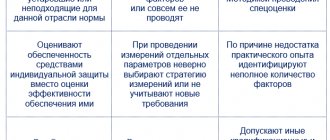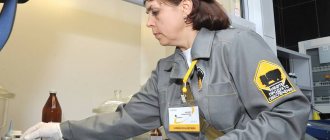During a special assessment, employees of surgical departments were established with acceptable working conditions based on the biological factor (working with pathogenic microorganisms).
Doctors do not agree with this situation. They believe that since they work with blood and other biological secretions, they work with pathogenic microorganisms. Let's look at this issue in the article. Find out what the government agencies have to say about this. Article navigation
- Regulatory and legal framework for assessing the impact of a biological factor
- Complete list of work with pathogenic microorganisms
- The procedure for determining the impact of a biological factor (working with pathogenic microorganisms)
On assessing working conditions based on biological factors
What is a biological factor in SOUT?
During the course of work, an employee is exposed to numerous factors, which can subsequently adversely affect health, affect the reproductive functions of the body, reduce immunity and contribute to the development of serious pathologies. What these factors are, only specialists authorized to carry out this work can give a correct assessment.
If there are excess levels of harmful factors in the workplace, then the employee is entitled to compensation for the working conditions provided, which, in turn, depend on how many times they exceed the norm.
The impact of the following factors on the body is considered by experts:
- physical;
- biological;
- chemical.
In this case, the class of the workplace is determined according to the SOUT map.
What is the biological effect on the human body? This is the effect of pathogenic organisms on the human body, including cells and spores contained in drugs, as well as in infected material.
An assessment of the conditions of the labor process for the presence and excess of a biological factor that can ultimately provoke viral pathologies is carried out only in the case when living microorganisms are used in the work algorithm.
Laboratory news
The Ministry of Labor of Russia explained the specifics of classifying working conditions in the workplace of medical and other workers as a class or subclass of working conditions under the influence of a biological factor
In particular, the following is reported:
assignment of working conditions to the class (subclass) of working conditions under the influence of a biological factor (working with pathogenic microorganisms) is carried out regardless of the concentration of pathogenic microorganisms and without conducting research (tests) and measurements in relation to the workplaces of medical and other workers directly involved in medical activities;
the need to provide licenses confirming the right to work with pathogenic microorganisms applies only to activities in the field of using pathogens of infectious diseases in humans and animals (except for the case if the specified activity is carried out for medical purposes) and genetically engineered modified organisms of III and IV degrees of potential danger carried out in closed systems;
the presence of a position name in the Nomenclature of Positions of Medical Workers and Pharmaceutical Workers, and in the job description of a medical or other employee of a medical organization (institution), developed in accordance with the Unified Qualification Directory of Positions of Managers, Specialists and Employees (US), at least one compliance with the definition of the concept “ medical activity" is a sufficient basis for further classification of working conditions, taking into account pathogenicity groups, into a class (subclass) of working conditions without conducting research (tests) and measurements;
assignment of working conditions to a class (subclass) of working conditions under the influence of a biological factor is carried out depending on the group of pathogenicity of microorganisms (causative agents of infectious diseases) using Appendix No. 9 to the Methodology for conducting a special assessment of working conditions, approved by Order of the Ministry of Labor of Russia dated January 24, 2014 N 33n;
in a special assessment of working conditions, all pathogenic microorganisms (causative agents of infectious diseases) that affect the employee during medical activities are taken into account, based on the presence of potential contact with infected patients or with infected biological material, including blood, secretions (external and internal) of the human body , taking into account the mechanisms and routes of transmission of pathogenic biological agents (pathogenic microorganisms);
to confirm the presence in the workplaces of medical and other workers directly engaged in medical activities, contact with pathogenic microorganisms - causative agents of infectious diseases (working under the influence of a biological factor) and further classifying working conditions in the workplace as a class (subclass) of working conditions based on a biological factor Data from the documentation available in a medical organization is used, which reflects the main and concomitant diseases of patients, as well as data from federal statistical observation forms. Information obtained during the study of the specified medical documentation and/or from the federal statistical surveillance forms mandatory for provision by a medical organization is a sufficient basis for establishing the names of diseases and pathogenicity groups of the causative agents of these infectious diseases (the statute of limitations of the information should not exceed a period of five years on the day of the special assessment of working conditions);
the employee has the right to contact the employer, his representative, the organization conducting a special assessment of working conditions, an expert of the organization conducting a special assessment of working conditions, with proposals for identifying potentially harmful and/or dangerous production factors at his workplace.
Source: https://www.consultant.ru/document/
MINISTRY OF LABOR AND SOCIAL PROTECTION OF THE RUSSIAN FEDERATION N 15-1/10/B-7756 MINISTRY OF HEALTH OF THE RUSSIAN FEDERATION N 16-6/10/2-6553 TRADE UNION OF HEALTH WORKERS OF THE RUSSIAN FEDERATION N 01-A/4 75 LETTER dated October 9, 2021
During the validity of the Federal Law of December 28, 2013 N 426-FZ “On Special Assessment of Working Conditions” (hereinafter referred to as Law N 426-FZ), questions most often arise related to the assignment of working conditions at the workplace of medical and other workers to the class (subclass ) working conditions when exposed to biological factors. In order to implement Law No. 426-FZ, by order of the Ministry of Labor and Social Protection of the Russian Federation dated January 24, 2014 No. 33n, the Methodology for conducting a special assessment of working conditions (hereinafter referred to as the Methodology) was approved. The assignment of pond conditions to the class (subclass) of working conditions under the influence of a biological factor (working with pathogenic microorganisms) in accordance with paragraph two of clause 29 of the Methodology is carried out regardless of the concentration of pathogenic microorganisms and without conducting research (tests) and measurements in relation to the workplaces of medical and other workers, directly carrying out medical activities. For reference: The need to provide licenses confirming the right to work with pathogenic microorganisms, in accordance with Federal Law dated May 4, 1999 N 99-FZ “On licensing of certain types of activities,” applies only to workplaces of organizations operating in the field of using pathogens of human infectious diseases and animals (except for the case if the specified activity is carried out for medical purposes) and genetically engineered modified organisms of III and IV degrees of potential danger, carried out in closed systems. In accordance with Article 2 of the Federal Law of November 21, 2011 N 323-FZ “On the fundamentals of protecting the health of citizens in the Russian Federation,” a medical worker is an individual who has a medical or other education, works in a medical organization and whose labor (official) responsibilities includes the implementation of medical activities, or an individual who is an individual entrepreneur directly engaged in medical activities. At the same time, medical activities are professional activities related to the provision of medical care, medical examinations, medical examinations and medical examinations, sanitary and anti-epidemic (preventive) measures and professional activities related to transplantation of organs and (or) tissues, circulation of donor blood and (or) its components for medical purposes. Order of the Ministry of Health of Russia dated December 20, 2012 N 1183n approved the Nomenclature of positions for medical workers and pharmaceutical workers (hereinafter referred to as the Nomenclature). The specified Nomenclature also provides for positions of specialists with higher professional (non-medical) education, whose work is related to the implementation of medical activities. The qualification characteristics of positions of workers in the healthcare sector are approved by Order of the Ministry of Health and Social Development of Russia dated July 23, 2010 N 541n “On approval of the Unified Qualification Directory of Positions of Managers, Specialists and Employees (hereinafter referred to as the EKS), section “Qualification characteristics of positions of workers in the healthcare sector”, which are used as regulatory documents, and also serve as the basis for the development of job descriptions containing a specific list of job responsibilities, taking into account the characteristics of the work of employees of medical organizations. The EKS provides for the qualification characteristics of the position of a medical specialist, which is applied to the positions of medical specialists for which the EKS does not have separate qualification characteristics. Thus, the presence of a position name in the Nomenclature, and in the job description of a medical or other employee of a medical organization (institution), developed in accordance with the CAS, at least one compliance with the definition of the concept of “medical activity” is a sufficient basis for further classification of working conditions taking into account groups pathogenicity to a class (subclass) of working conditions without conducting research (testing) and measurements. The assignment of working conditions to a class (subclass) of working conditions when exposed to a biological factor is carried out depending on the group of pathogenicity of microorganisms (pathogens of infectious diseases) using Appendix No. 9 to the Methodology. Experts and (or) other employees of organizations conducting a special assessment of working conditions classify pathogenic agents of infectious diseases (pathogenic microorganisms) into the pathogenicity group by comparing and establishing matches by the name of the diseases. The pathogenicity group of microorganisms is determined in accordance with the “Classification of biological agents that cause human diseases by pathogenicity groups” (Appendix No. 3 to the Sanitary and Epidemiological Rules SP 1.3.3118-13 “Safety of working with microorganisms of I - II groups of pathogenicity (hazard), approved Resolution of the Chief State Sanitary Doctor of the Russian Federation dated November 28, 2013 N 64) (hereinafter referred to as SP 1.3.3118-13) and “Classification of microorganisms that cause infectious diseases in humans, protozoa, helminths and poisons of biological origin by pathogenicity groups” (Appendix N 1 to the Sanitary and Epidemiological Rules SP 1.3.2322-08 “Safety of working with microorganisms of III - IV groups of pathogenicity (danger) and pathogens of parasitic infections, approved by the Decree of the Chief State Sanitary Doctor of the Russian Federation dated January 28, 2008 N 4) (hereinafter - SP 1.3.2322-08). For the purpose of special assessment of working conditions, other provisions of the sanitary and epidemiological rules SP 1.3.3118-13 and SP 1.3.2322-08 do not apply. When specially assessing working conditions, all pathogenic microorganisms (causative agents of infectious diseases) that affect the employee during medical activities are taken into account, based on the presence of potential contact with infected patients, or with infected biological material, including blood, secretions (external and internal) of the body humans, taking into account the mechanisms and routes of transmission of pathogenic biological agents (pathogenic microorganisms). As initial materials when conducting a special assessment of working conditions at the workplace of medical and other workers directly involved in medical activities, along with the documents listed in paragraph 4 of the Methodology, statistical reporting data provided by the organization in the prescribed manner to higher authorities about existing or existing infectious diseases in patients, which determine the presence of exposure to a biological factor in working conditions in the workplace. To confirm the presence at the workplace of medical and other workers directly engaged in medical activities, contact with pathogenic microorganisms - causative agents of infectious diseases (working under the influence of a biological factor) and further classifying the working conditions in the workplace as a class (subclass) of working conditions according to the biological factor Data from the documentation available in the medical organization is used, which reflects the main and concomitant diseases of the patients (patients), as well as data from federal statistical observation forms. For example, by orders of Rosstat: - dated January 28, 2009 N 12, Form N 8 “Information on diseases of active tuberculosis” was approved; — dated December 31, 2010 N 483, form N 33 “Information about tuberculosis patients” was approved; — dated December 30, 2015 N 672, Form N 61 “Information on the disease caused by the human immunodeficiency virus” was approved; — dated July 21, 2016 N 355, Form N 12 “Information on the number of diseases registered in patients living in the service area of a medical organization” was approved; — dated December 22, 2016 N 866, Form N 14 “Information on the activities of units of a medical organization providing medical care in inpatient settings” was approved; - and others. Information obtained during the study of the specified medical documentation and (or) from federal statistical surveillance forms mandatory for submission by a medical organization is a sufficient basis for establishing the names of diseases and pathogenicity groups of the causative agents of these infectious diseases. The statute of limitations for information should not exceed a period of five years as of the date of the special assessment of working conditions. For example: In the course of providing medical care to a patient with ARVI, type I herpes and syphilis at the workplace of a worker directly engaged in medical activities, pathogenicity group III is established, in accordance with the Classification of biological agents that cause human diseases, by pathogenicity groups, which corresponds to being in this group of the causative agent of syphilis - Treponema pallidum. When further classifying the working conditions of an employee's workplace as a class (subclass) of working conditions under the influence of a biological factor using Appendix No. 9 to the Methodology, this corresponds to the harmful class of working conditions of the second degree (subclass 3.2). When providing medical care to a patient with rhinitis, gastroenteritis, tuberculosis and HIV-infected, the assignment of working conditions in the workplace to the class (subclass) of working conditions under the influence of a biological factor is established according to the highest group II pathogenicity of microorganisms, which includes pathogens of the human immunodeficiency virus (HIV), which, when using Appendix No. 9 to the Methodology, corresponds to the harmful class of working conditions of the third degree (subclass 3.3). Thus, the information in the above and other forms of statistical reporting, required to be provided by a medical organization, is fundamental for classifying the working conditions of medical and other workers into the class (subclass) of working conditions when exposed to a biological factor. In addition, in accordance with Article 5 of Law N 426-FZ, the employee has the right to contact the employer, his representative, the organization conducting a special assessment of working conditions, an expert of the organization conducting a special assessment of working conditions, with proposals for carrying out identification at his workplace potentially harmful and (or) hazardous production factors. In this regard, simultaneously with the collection of initial data, it is recommended to conduct a survey of workers to determine whether they have proposals for identifying harmful and (or) hazardous production factors at their workplaces, taking into account the fact that the Federal Law does not limit the composition of those to be identified at the request of workers harmful production factors. The results of this survey are documented in the minutes of the meeting of the Commission for a special assessment of working conditions at the employer (hereinafter referred to as the Commission), which indicates the names of workplaces and their number, the names of positions and the number of workers employed in them, as well as a list of harmful production factors to be identified at each the workplace where the employees who made the proposal are employed. All of the above initial data are transferred to the representative of the organization conducting a special assessment of working conditions and its expert for further work with the Commission drawing up a transfer act, which lists the transferred materials and is signed by the chairman and members of the Commission, including a representative of the primary trade union organization or other representative workers' body (if any), as well as a representative of the organization conducting a special assessment of working conditions, and its expert. At the same time, the employer agrees on the expert’s work schedule and ensures that he is accompanied by a member of the commission for conducting a special assessment of working conditions (for example: a labor protection specialist or a person assigned his functions by order). For reference: In relation to workplaces provided for in Part 6 of Article 10 and Part 1 of Article 11 of Law N 426-FZ, identification of potentially harmful (hazardous) production factors is not carried out, and a declaration of compliance of working conditions with state regulatory labor protection requirements is not issued. According to Part 6 of Article 10 of Law N 426-FZ, identification of potentially harmful and (or) dangerous production factors is not carried out in relation to: 1) workers’ workplaces, professions, positions, specialties of which are included in the lists of relevant works, industries, professions, positions, specialties and institutions (organizations), taking into account which the early assignment of an old-age insurance pension is carried out; 2) workplaces in connection with the work in which employees, in accordance with legislative and other regulatory legal acts, are provided with guarantees and compensation for working under harmful and (or) dangerous working conditions; 3) workplaces where, based on the results of previously conducted certification of workplaces for working conditions or a special assessment of working conditions, harmful and (or) dangerous working conditions were established. At the same time, please note that in accordance with Article 4 of Law N 426-FZ, the employer is required not to take any deliberate actions aimed at narrowing the range of issues to be clarified during a special assessment of working conditions and affecting the results of its implementation. This letter expresses the position of the signatories for use in their work.
Ministry of Labor and Social Protection of the Russian Federation Deputy Minister G.G. LEKAREV Ministry of Health of the Russian Federation First Deputy Minister T.V. YAKOVLEVA Trade Union of Healthcare Workers of the Russian Federation Chairman M.M. KUZMENKO
Who has the right to conduct research
Who can work with pathogenic microorganisms
Every organization engaged in research or work with pathogenic microorganisms must have a conclusion from Rospotrebnadzor authorizing the use of these bacteria. In particular, it is necessary to provide for the availability at workplaces of instructions on the use of infected material in work, agreed with the same body.
Complete list of work with pathogenic microorganisms
The right to work with pathogenic microorganisms is confirmed by a sanitary-epidemiological certificate (SEZ) for each facility where such work will be carried out (Part 3 of Article 26 of the Federal Law of March 30, 1999 No. 52-FZ “On the Sanitary and Epidemiological Welfare of the Population”).
Carrying out work with pathogenic microorganisms without a sanitary and epidemiological conclusion is a violation of the legislation of the Russian Federation on sanitary and epidemiological welfare and grounds for suspension, termination and revocation of a license.
Blood is not itself a pathogenic microorganism. Whether it is infected or not is determined by the laboratory . Blood is a liquid and mobile connective tissue of the internal environment of the body. The patient is not a pathogenic microorganism. A patient of a medical organization may be a potential carrier of various infections, but this can only be determined after appropriate tests have been carried out. The tests are carried out by the laboratory.
Complete list of work with pathogenic microorganisms
| SP 1.3.3118-13 | SP 1.3.2322-08 |
| diagnostic (studies of objects of biotic and abiotic nature, carried out with the aim of detecting, isolating and identifying the pathogen, its antigen or antibodies to it) | diagnostic for the purpose of detecting and isolating the pathogen, experimental and production work with group III PBA (without accumulation of the pathogen) |
| nucleic acid detection research | PCR diagnostics - diagnostic tests for cholera and botulinum toxin, performed by the laboratory department to prevent these infections |
| experimental (all types of work using microorganisms and products of their microbiological synthesis, prions, toxins and poisons of biological origin) | immunological studies with group III PBA |
| production (work on the production of vaccines, serums, immunoglobulins and others using microorganisms and products of their microbiological synthesis) | immunological studies to detect in human blood antigens of microorganisms of group II pathogenicity (without accumulation of the pathogen) and/or antibodies to them |
| in hospitals (hospitals), isolation wards and observatories for the provision of specialized medical care | experimental and production work with vaccine strains of pathogens of pathogenicity groups I-II, officially classified as group III |
| pathological-anatomical autopsy of human corpses and dead animals | |
| evacuation of patients with especially dangerous infectious diseases and in infectious foci of diseases |
Bloodborne infection is an infection transmitted by contact with infected blood or blood products and causing an infectious disease that occurs in emergency situations. If an emergency occurs at the workplace, personnel are obliged to act according to instructions for the prevention of HIV infection and other infectious diseases.
Scraping is a method of taking material for subsequent identification of microflora and pathological process in the laboratory. Therefore, doctors who take swabs from patients also do not work with pathogenic microorganisms. Whether the smear is infected or not is determined by the laboratory. Scraping is carried out in compliance with the requirements of sanitary rules.
Any emergency situation becomes possible for two main reasons:
- Insufficient qualifications of personnel when performing medical procedures
- Gross violation of safety rules
In any case, the employer will be found guilty of the accident , and the fault of the victim will not exceed 25%, according to Part 1 of Art. 14 of the Federal Law of July 24, 1998 No. 125-FZ “On compulsory social insurance against industrial accidents and occupational diseases.”
Example:
During an operation, a surgeon inadvertently cut himself with a scalpel while operating on a patient with a known diagnosis of Hepatitis C. During an investigation into a case of acute occupational disease, the doctor explained that he lost his vigilance and forgot to put on chain mail gloves while operating on a patient with hepatitis C wearing only latex gloves. According to the rules, the doctor must first put on surgical latex gloves, then put on chain mail gloves, then put on latex gloves on the chain mail gloves again. Thus, a gross violation by the employee himself of universal safety measures for medical activities was the cause of nosocomial infection.
Therefore, laboratory doctors may be exposed to harmful working conditions due to the fact of working with pathogenic microorganisms.
Surgical doctors are also at risk of infection, but are obliged to protect themselves by applying safety measures prescribed in sanitary rules and instructions. However, they do not carry out work on studying the causative agent of infectious diseases at the cellular level, unlike the staff of laboratory departments.
For the same reason, a nurse in a laboratory department cannot claim harmful working conditions due to a biological factor. Yes, she is at risk of infection, but in violation of universal health safety measures. But she doesn't do enzyme immunoassays or antibody studies.
How is the hazard class determined?
Based on changes and additions to the legislation, only work on diagnosing, conducting research and experiments in relation to pathogenic substances are classified as harmful classes in relation to the biological factor.
Organizations of this type include:
- Those that use infectious agents in their work, and their hazard class is 3 or 4. These can be highly specialized laboratories, research institutes and other organizations.
- Laboratories engaged in the study of microorganisms that have passed the established accreditation.
- Medical workers engaged in activities in accordance with their specialization.
- Veterinary services.
The expert organization provides the results of the special assessment to the structure that has entered into an agreement with it.
Groups of substances by pathogenicity
Division into groups according to danger and pathogenicity
When assessing working conditions, the possibility of workers coming into contact with hazardous biological factors is not taken into account. After concluding contractual obligations, the customer must prepare a list of works with a detailed indication of hazardous factors, and the group according to their affiliation is indicated. Groups 1 and 2 in terms of danger, 3 or 4 in terms of pathogenicity.
Dangerous infections include: polio, smallpox, influenza with severe respiratory syndrome, HFRS and anthrax. Bacteria of the pathogenic type include: spores of harmful microbes, bacteria, viruses, toxic manifestations, fungi and other breeding materials that contain pathogens.
When assessing working conditions, all biological factors that contribute to the development of viral pathology are taken into account. In addition, the effect on the body of dangerous microbes in the presence of its own is taken into account.






